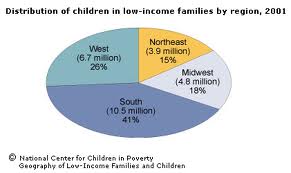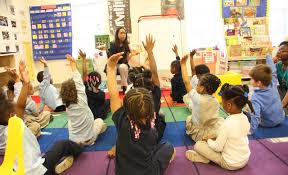As a school board member, I am concerned about (1) the increasing number of Americans living in poverty and (2) how well (or unwell) families with low-income fare within our educational institutions. Current U.S. poverty rates estimate 46.2 million Americans (15 percent of the population) live at or below poverty levels.
Poverty is a growing problem in America; it costs our economy hundreds of billions of  dollars every year. More than one in five U.S. children live in poverty, and the rate is even higher for black children, Hispanic children, and for families headed by a single parent. Children growing up in poverty complete less schooling, work and earn less as adults, are more likely to receive public assistance, and have poorer health.
dollars every year. More than one in five U.S. children live in poverty, and the rate is even higher for black children, Hispanic children, and for families headed by a single parent. Children growing up in poverty complete less schooling, work and earn less as adults, are more likely to receive public assistance, and have poorer health.
How does income disparity ultimately affect human capital? Human capital is defined as the skills, education, health, and training of individuals. It is capital because skills and education are an integral part of us that is long-lasting. There is a relationship between the investments we make in human capital and alleviation of poverty.
Human capital creates two-thirds of a modern economy’s wealth. That’s a pretty compelling argument for why we need to encourage greater educational attainment. And not surprisingly, we’re finding that educational opportunities need to be offered earlier in a child’s life. For example, increasing educational opportunities from birth to age five provides society with a significant payoff—7% to 10% on the dollar, says Nobel laureate economist James Heckman. The payoff comes in the form of academic success, future productivity and economic prosperity.
 Kids from low-income homes reporting to school for the first time face increasing obstacles in school achievement, compared to classmates that come from higher income levels. It costs money to nurture cognitive and social skills in children, and money is tight at all levels of government. But not doing something about the problem creates a future perfect storm of fewer and fewer Americans becoming productive members of society.
Kids from low-income homes reporting to school for the first time face increasing obstacles in school achievement, compared to classmates that come from higher income levels. It costs money to nurture cognitive and social skills in children, and money is tight at all levels of government. But not doing something about the problem creates a future perfect storm of fewer and fewer Americans becoming productive members of society.
Strategies to decrease poverty and increase human capital include:
• Raise awareness of the relationship of poverty to human capital and its long-term cultural consequences.
• Provide adequate funding for our schools. The economic downturn has taken a toll on state school funding; especially preschool programs that can help disadvantaged children.
• Broaden access to high-quality preschool education. Early childhood education programs improve the educational outcomes of all children, but in particular, low-income children.
Research has shown a strong association between educational success and economic advantage. Therefore, you would expect current educational policies to focus on trying to overcome the effects of poverty on children. Instead, the national focus is to treat all students the same by using common core curriculum standards and test-based accountability systems. Those efforts will not close achievement gaps, primarily because they disregard the educational challenges that children in poverty face every day. Americans need to commit to successful pathways for all children. As Benjamin Franklin once said, “An investment in education pays the best interest.”
Written By:
Donna Green, Extension Educator, Family & Consumer Sciences, Ohio State University Extension
Reviewed by:
Betsy DeMatteo, Extension Educator, Family & Consumer Sciences, Ohio State University Extension
Sources:
Click to access Social_Capital_and_Educational_Attainment.pdf
Click to access Milken%20Matter-of-Degrees%20Education%20Report%20Feb_2013.pdf

